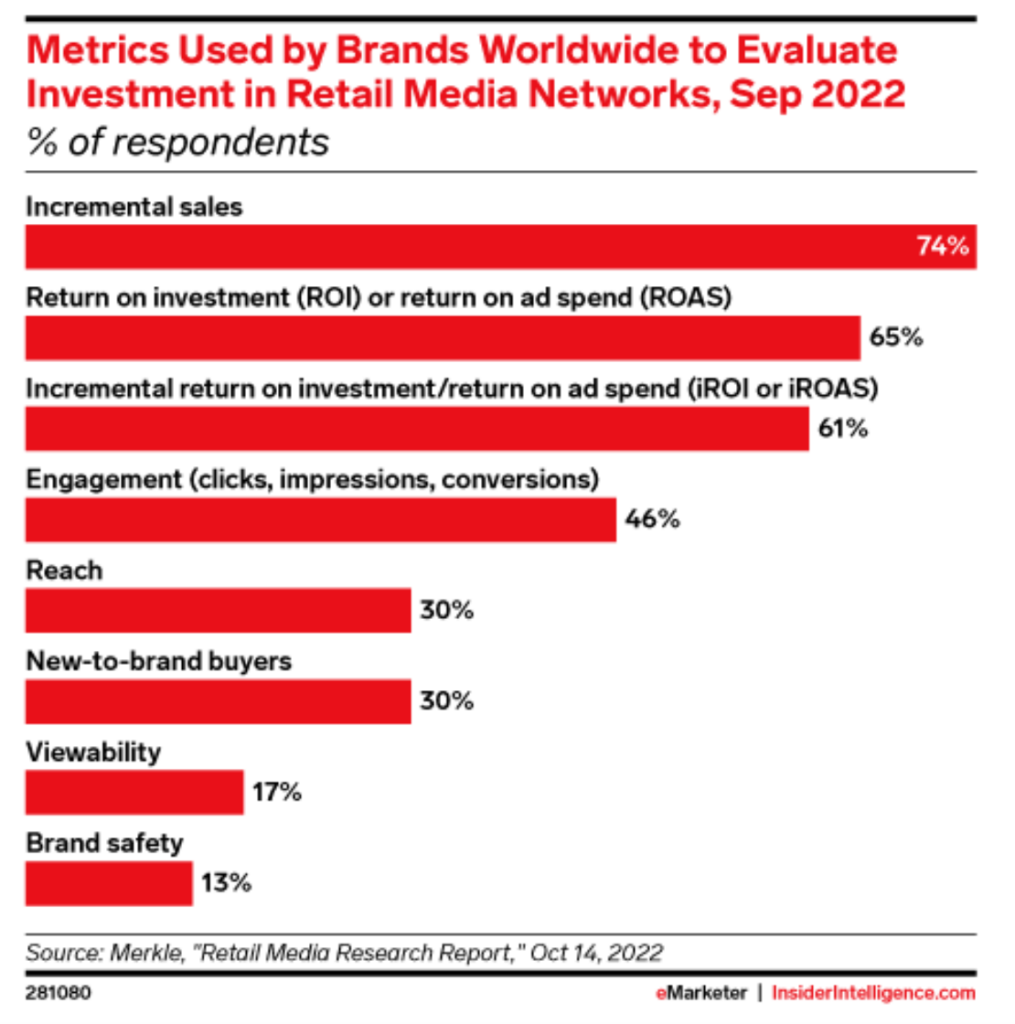
3 Ways to Win with RMNs
Retail Media Networks (RMNs) are among the fastest growing and most dynamic ad marketplaces in the US. Dozens of Retail Media Networks have emerged in recent years, with almost every leading digital marketplace, national grocery chain, category retailer and delivery provider getting into the game. The increased competition in the RMN space has already led to a plethora of new innovations, but there’s still an abundance of opportunities to capitalize on.

According to Insider Intelligence, RMN’s are expected to grow faster than any other major US ad channel and will soon surpass the traditional TV channel in terms of media spending (Graph above, source: Retail Media Ad Spending Forecast 2022). For both brands and RMNs to be successful and grow, it’s important for them to work closely and in harmony with each other. Ways this can be achieved:
1. Have a unified brand strategy:

For brands to make the most of this new channel and expand their audience reach, it’s important for them to align internally and include all the relevant stakeholders in the planning and strategy process. According to Matt Drzewicki (VP Partner Solutions at Roundel, Target’s RMN) the most productive meetings are the ones where all stakeholders are present to discuss the business goals the brand is trying to achieve and what role RMN can play in helping them achieve those goals.
2. Data transparency and measurement:
Brands are interested in measuring the performance (such as incrementality, unique reach, etc.) across all platforms and retailers. The only way a brand can do this is to have access to the data, which has been an uphill battle for brands and retailers. According to Mike Merna (Chief Growth Officer, Mars Agency), retailers are doing brands a disservice by not providing them with more data. Providing data is one part of the equation, but brands also need to have complete transparency with retailers. Each stakeholder may have a different attribution model and transparency ensures the brands can measure their performance accurately.
3. Partnership to enable more upper-funnel tactics:
According to Danielle Brown (SVP Data Enablement & Content Strategy, Disney Advertising Sales), the next wave of retail media will be marked by collaboration between advertisers, retailers and media companies. One good example of this is the partnership between Walt Disney Co. & Kroger which took place earlier this year. The partnership enabled the brands to more accurately target streaming audiences using First-Party shopper data. The question that brands and RMNs need to answer now is how to leverage mid and upper funnel tactics for audience expansion to further build their lower funnel.
AdParlor POV:
The impact of Retail Media Networks on digital advertising cannot be understated. We foresee retail media continuing to be the fastest growing channel in the coming years. All stakeholders (brand, advertisers and RMNs) need to work together, toward unified goals, in order to maximize return. With the introduction of tools such as Meta’s MPA Lite (Manager Partner Ads Lite), platforms are empowering stakeholders to achieve their goals. With MPA lite, Meta is able to harness the power of first party CRM Data to drive sales for specific brands on the Retail Media Network. We anticipate additional platforms will roll out their own versions of MPA to stay competitive. Although the end goal of most businesses is to generate sales, we cannot forgo the importance of building mid and upper funnels. RMNs provide brands with an opportunity for audience expansion, by reaching customers which otherwise would not have been introduced to the brand.
Lack of an industry-wide measurement standard has made it challenging for advertisers to measure performance on RMNs. To provide more timely and accessible data for RMN social campaigns, AdParlor’s Adfuel solution allows retailers or brands the ability to build custom dashboards with custom metrics for actionable insight.
Source: Insider Intelligence

Understanding and leveraging the relationship between Retail Media, Influencer Integration and Tech Partnership to Amplify Affiliate Marketing Results
Brands are continuously working on building synchrony between their different marketing channels in order to generate incremental revenue. One popular channel is affiliate marketing. According to Alexendra Forsch (President, Awin Americas), affiliate marketing has always been considered as a tactical channel instead of a strategic channel mainly because of lack of confidence in its potential. But this is now changing, with the convergence of affiliate marketing, retail media networks, influencer marketing and tech partnerships, this channel is now emerging as a full funnel channel. Each of these have different impacts on affiliate marketing:
- Rise of Retail Media Networks:
With the growth of RMNs, brand to brand partnerships facilitated through affiliate channels give smaller brands an opportunity to grow by reaching new affinity audiences, which otherwise wouldn’t have been possible.
- The Creator Role:
Another channel which has seen huge growth in recent years is Influencer marketing, consumers rely on influencers to review products, services and also share new products they come across/liked. With a data driven approach, brands can work with influencers in an affiliate partnership, which allows the brand to pay creators based on sales they generate vs. a flat fee agreement.
- Tech Partnerships:
Innovations in affiliate marketing have increased opportunities to convert shoppers to buyers. With On-Site optimization (based upon customer’s behavior on the website), personalized product recommendations and couponing, brands are able to improve conversion rates and generate incremental sales.
AdParlor POV:
Growth of newer channels (RMNs) paired with growth of existing ones (influencer + affiliate marketing) and topped with innovations in shopping experiences present a breadth of endless opportunities and challenges. A good marketing campaign is one which is designed to keep the customer’s journey in mind. From the point of exposure all the way to the final purchase made on the website, it’s crucial to consider all touchpoints along the way. Influencer marketing is no longer limited to creating brand awareness and engagements, but using fully managed influencer marketing solutions such as AdParlor’s CreatorFuel, advertisers can generate conversions and increase reach and brand awareness.
An average consumer is exposed to hundreds of ads daily, seeing relevant offers and products not only improves customers’ online shopping experience (which reduces the bounce rate and increase’s time spent on the website) but also helps businesses generate incremental sales through cross/up selling. Retail Media Networks play an important role in this by helping brands target their most profitable customers using first-party data. Pairing this with tools such as Fluent’s adflow commerce media solution, which provides exclusive advertising inventory on retailers’ post-transaction page and can help deliver the most relevant and personalized offers in the most optimal purchase moment for customers to engage.
Source: Insider Intelligence
Should ROAS be the primary metric to measure the performance of RMN?
One of the biggest challenges that brands and performance marketers face is measuring the performance of their Retail Media Network campaigns. According to data from Criteo (May 2022), the most valuable metric to assess performance of campaigns on RMNs is not Return On Ad Spend (ROAS) but rather incrementality.
According to Andrew Lipsman (Analyst, Insider Intelligence), ROAS does not give the true picture of the performance of the campaign. If the targeting of the campaign is too narrow (niche) it could result in high ROAS but won’t necessarily result in any significant increase in the volume of purchases. Similarly, one of the strengths of RMNs are search ads but they too come with a set of challenges when it comes to measuring performance. For example, if a customer searches for a product (already has an intent of buying it), sees a sponsored ad and makes a purchase, it’s difficult to measure the true causality of the ad exposure.

There are other metrics such as incremental sales, reach and engagement that can be used to assess the performance of their campaigns on RMNs (graph below).

Role of incrementality:
Brands want to better measure the incrementality resulted from marketing on RMNs. 37% of the retail media decision makers in North America said that the inability to prove incrementality is one of the major reasons from slow investment growth in RMNs (Skai & BWG Strategy report, January 2023).
Incremental expansion of reach:
One of the core strengths of RMNs is the audience expansion. This expansion is not necessarily limited to online reach as most customer reach happens off-site and in-store, which is why it’s important to measure incrementality on both on-site and off-site channels.
AdParlor POV:
Brands want to measure performance of their campaigns in order to make informed decisions, no matter the channel. With the growth of RMNs, the need to accurately measure the performance of campaigns is increasing. Historically, ROAS has been the key metric when assessing performance but ROAS does not always depict a clear picture.
As some brands have experienced, a campaign can have high ROAS but very little increase in the incremental number of purchases. At the same time, if either party hasn’t bridged the connection between each of their data signals (i.e. in-store and app-based purchases), ROAS might not always account for additional conversions that may have happened offline.
It’s important to have a holistic approach while analyzing the performance of the campaigns. This can be done by incorporating omnichannel and offline data into the analysis when measuring the performance. Other metrics such as unique reach, CP1K Reach, CPM, CPC should also be factored in while analyzing the performance.
Another hurdle is measuring brand specific conversions and incrementality. If you don’t have custom conversions set up for the brands promoted, it’s impossible to segment out purchases made for one particular brand in comparison to all ecomm purchases. Meta’s MPA Lite solution can be a beneficial tool as the campaigns can optimize performance toward a brand-specific conversion. You can also get a glimpse into granular SKU-level reporting, which hasn’t been offered by Meta in the past.
Advertisers are becoming more aware of the importance of incrementality and the role RMNs play in it. Account-level conversion lift studies can help all stakeholders understand the performance of the campaign beyond standard metrics like Return on Ad Spend (ROAS) and CPP (Cost Per Purchase). Reach out to our team if you have any outstanding measurement questions or would like to learn more!
Source: Insider Intelligence
If you are looking to unlock growth and grow your business, we can help! Let’s chat
About AdParlor
AdParlor, an agency established in 2008 and now a division of Fluent (NASDAQ: FLNT), is a leading provider of data-driven digital media strategy and execution that unlocks explosive growth for world-class and disruptive brands. Through our GrowthFuel framework we offer proprietary performance marketing solutions that have scaled our clients’ programs profitably, with our clients’ success being our sole agenda. Our custom technology solves problems related to creative insights, creative production, real time cross-platform reporting and more. Brands choose AdParlor because our unmatched expertise in ecommerce digital media delivers impactful full-funnel performance campaigns for profitable growth.
